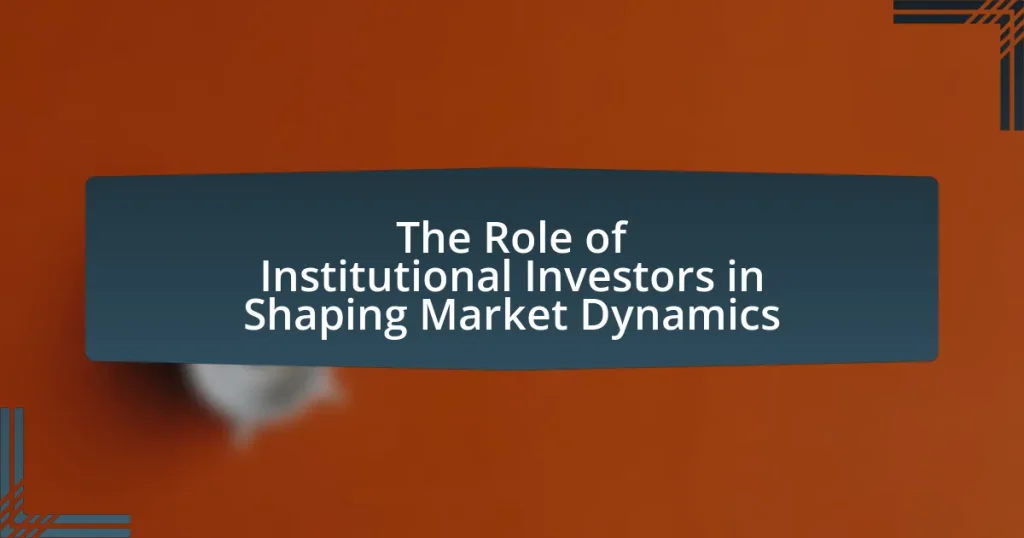Institutional investors, including pension funds, insurance companies, and mutual funds, play a pivotal role in shaping market dynamics by influencing liquidity, price stability, and corporate governance. They manage trillions of dollars in assets, significantly impacting market trends through their trading activities and investment strategies, which include asset allocation, diversification, and both active and passive management. The article explores how these investors affect market volatility, contribute to liquidity, and engage in corporate governance, while also addressing the challenges they face, such as regulatory changes and market risks. Additionally, it highlights future trends in institutional investing, including a focus on sustainable practices and the integration of advanced technology in investment strategies.

What is the Role of Institutional Investors in Shaping Market Dynamics?
Institutional investors play a crucial role in shaping market dynamics by influencing liquidity, price stability, and corporate governance. These investors, which include pension funds, insurance companies, and mutual funds, collectively manage trillions of dollars in assets, significantly impacting market trends and investor behavior. For instance, their large-scale buying and selling can lead to substantial price movements, as seen during the 2008 financial crisis when institutional sell-offs contributed to market volatility. Additionally, institutional investors often advocate for better corporate governance practices, pushing companies to adopt strategies that enhance long-term shareholder value, thereby affecting overall market performance. Their investment decisions are often based on extensive research and analysis, which can set trends that other market participants follow, further solidifying their influence on market dynamics.
How do institutional investors influence market trends?
Institutional investors influence market trends primarily through their substantial capital allocations and trading activities. By managing large pools of assets, such as pension funds, mutual funds, and insurance companies, they can significantly impact stock prices and market liquidity. For instance, when institutional investors decide to buy or sell large quantities of securities, their actions can lead to noticeable price movements, as seen during the 2008 financial crisis when institutional selling contributed to market volatility. Additionally, their investment strategies often set benchmarks for other market participants, further shaping market dynamics.
What are the primary strategies employed by institutional investors?
Institutional investors primarily employ strategies such as asset allocation, diversification, active management, and passive management. Asset allocation involves distributing investments across various asset classes to optimize risk and return. Diversification reduces risk by investing in a wide range of securities, thereby minimizing the impact of any single investment’s poor performance. Active management seeks to outperform market indices through selective buying and selling of securities based on research and analysis. In contrast, passive management aims to replicate the performance of a specific index, often through index funds or exchange-traded funds (ETFs). These strategies are supported by data indicating that institutional investors, who manage trillions of dollars in assets, significantly influence market trends and pricing through their investment decisions.
How do these strategies impact market volatility?
Institutional investors’ strategies significantly impact market volatility by influencing trading volumes and price movements. For instance, large-scale buying or selling by these investors can lead to abrupt price changes, as seen during the 2008 financial crisis when institutional sell-offs contributed to heightened market fluctuations. Additionally, strategies such as algorithmic trading can exacerbate volatility by executing trades at high speeds, often leading to rapid price swings. Historical data shows that periods of heavy institutional trading correlate with increased volatility, highlighting their role in shaping market dynamics.
Why are institutional investors significant in financial markets?
Institutional investors are significant in financial markets because they manage large pools of capital, which allows them to influence market trends and pricing. Their substantial investments can lead to increased liquidity, as they often engage in high-volume trading, which helps stabilize markets. For example, as of 2021, institutional investors held approximately 70% of the U.S. stock market, demonstrating their dominant presence and ability to impact stock prices and market movements. Additionally, their investment strategies often involve extensive research and analysis, contributing to more informed market behavior and efficient pricing mechanisms.
What advantages do institutional investors have over retail investors?
Institutional investors have several advantages over retail investors, primarily due to their access to resources, expertise, and market influence. Institutional investors typically manage large pools of capital, allowing them to negotiate better terms and lower fees on transactions compared to retail investors. For instance, they often benefit from reduced trading costs and access to exclusive investment opportunities that are not available to individual investors. Additionally, institutional investors employ teams of analysts and portfolio managers who utilize sophisticated research and data analytics, enabling them to make informed investment decisions based on comprehensive market insights. This professional management often results in better risk-adjusted returns over time. Furthermore, institutional investors can exert significant influence on corporate governance and market dynamics due to their substantial ownership stakes, which can lead to more favorable outcomes for their investments.
How do institutional investors contribute to market liquidity?
Institutional investors contribute to market liquidity by providing substantial capital and facilitating large transactions, which helps to narrow bid-ask spreads and stabilize prices. Their ability to execute large trades without significantly impacting market prices enhances overall market efficiency. For instance, according to a study by the CFA Institute, institutional investors account for approximately 70% of trading volume in U.S. equity markets, demonstrating their significant role in maintaining liquidity. This high trading volume allows for quicker transactions and better price discovery, ultimately benefiting all market participants.
What challenges do institutional investors face in market dynamics?
Institutional investors face several challenges in market dynamics, including market volatility, regulatory changes, and liquidity constraints. Market volatility can significantly impact investment strategies, as rapid price fluctuations may lead to increased risk and uncertainty. Regulatory changes, such as new compliance requirements or shifts in monetary policy, can alter the investment landscape, requiring institutional investors to adapt their strategies accordingly. Additionally, liquidity constraints can hinder the ability to buy or sell assets quickly without affecting their prices, particularly in less liquid markets. These challenges necessitate a proactive approach to risk management and strategic asset allocation to navigate the complexities of market dynamics effectively.
How do regulatory changes affect institutional investment strategies?
Regulatory changes significantly influence institutional investment strategies by altering the risk-return profile of various asset classes. For instance, new regulations can impose stricter capital requirements, compelling institutions to adjust their asset allocations to maintain compliance while optimizing returns. A notable example is the implementation of the Basel III framework, which increased capital requirements for banks, leading to a shift in investment strategies towards less capital-intensive assets. Additionally, changes in tax laws or fiduciary standards can prompt institutional investors to reassess their investment approaches, potentially favoring more tax-efficient or lower-risk investments. These adjustments are often driven by the need to align with regulatory expectations while achieving investment objectives, demonstrating the direct impact of regulatory environments on institutional investment behavior.
What risks are associated with institutional investing?
Institutional investing carries several risks, including market risk, liquidity risk, credit risk, and regulatory risk. Market risk arises from fluctuations in asset prices, which can significantly impact the value of investments held by institutions. Liquidity risk refers to the potential difficulty in buying or selling assets without affecting their price, particularly in times of market stress. Credit risk involves the possibility of loss due to a counterparty’s failure to meet contractual obligations, which can affect the stability of investment returns. Regulatory risk pertains to changes in laws or regulations that can impact investment strategies and operations. These risks are critical for institutional investors to manage, as they can influence overall portfolio performance and investment outcomes.
How do institutional investors interact with other market participants?
Institutional investors interact with other market participants primarily through trading activities, information sharing, and collaboration in investment strategies. They engage in large-scale transactions that can influence market prices and liquidity, often executing trades through brokers or directly with other institutional entities. For instance, according to a 2021 report by the CFA Institute, institutional investors account for approximately 70% of trading volume in U.S. equity markets, demonstrating their significant role in market dynamics. Additionally, they often participate in investor conferences and research collaborations, sharing insights and strategies that can shape market trends and investor behavior. This interaction not only impacts pricing but also contributes to the overall efficiency and stability of financial markets.
What specific roles do institutional investors play in corporate governance?
Institutional investors play a crucial role in corporate governance by influencing management decisions and promoting accountability. They achieve this through active engagement with company management, voting on shareholder resolutions, and advocating for best practices in governance. For instance, institutional investors often participate in annual general meetings, where they vote on key issues such as board elections and executive compensation, thereby shaping the strategic direction of companies. Research indicates that firms with significant institutional ownership tend to have better governance practices, as these investors push for transparency and ethical conduct, ultimately leading to enhanced shareholder value.
How do institutional investors influence company policies?
Institutional investors influence company policies primarily through their significant ownership stakes, which provide them with voting power and the ability to engage in shareholder activism. By holding large amounts of shares, these investors can sway decisions on corporate governance, executive compensation, and strategic direction. For instance, a study by the Harvard Law School Forum on Corporate Governance found that institutional investors, such as pension funds and mutual funds, often advocate for changes in management practices and sustainability initiatives, leading to enhanced accountability and transparency in companies. This influence is further amplified when institutional investors collaborate, forming coalitions to push for specific policy changes, thereby increasing their leverage over corporate boards.
What impact do they have on shareholder activism?
Institutional investors significantly enhance shareholder activism by leveraging their substantial ownership stakes to influence corporate governance and decision-making. Their large shareholdings provide them with the power to advocate for changes that align with shareholder interests, such as improved financial performance, sustainability practices, and executive compensation structures. For instance, a study by the Harvard Law School Forum on Corporate Governance found that institutional investors, particularly those with long-term investment strategies, are more likely to engage in activism, leading to positive changes in company policies and practices. This engagement often results in increased accountability and transparency from management, ultimately benefiting both shareholders and the broader market.
What are the future trends for institutional investors in market dynamics?
Future trends for institutional investors in market dynamics include increased focus on sustainable investing, integration of advanced technology, and enhanced risk management strategies. Institutional investors are increasingly prioritizing environmental, social, and governance (ESG) factors, as evidenced by a 2021 report from the Global Sustainable Investment Alliance, which indicated that global sustainable investment reached $35.3 trillion, a 15% increase from 2018. Additionally, the adoption of artificial intelligence and big data analytics is transforming investment strategies, allowing for more precise market predictions and portfolio management. Furthermore, as market volatility rises, institutional investors are expected to implement more sophisticated risk management frameworks to navigate uncertainties effectively.
How is technology changing the landscape for institutional investors?
Technology is transforming the landscape for institutional investors by enhancing data analysis, improving operational efficiency, and enabling better risk management. Advanced analytics and artificial intelligence allow institutional investors to process vast amounts of data quickly, leading to more informed investment decisions. For instance, according to a report by McKinsey, firms that leverage AI in investment strategies can achieve up to 20% higher returns compared to those that do not. Additionally, technology facilitates automation in trading and compliance processes, reducing costs and minimizing human error. Furthermore, blockchain technology is improving transparency and security in transactions, which is crucial for institutional investors managing large portfolios. These technological advancements collectively empower institutional investors to adapt to market changes more swiftly and effectively.
What emerging markets are institutional investors focusing on?
Institutional investors are increasingly focusing on emerging markets such as India, Brazil, and Southeast Asia. These regions are attracting attention due to their robust economic growth, demographic advantages, and expanding middle class. For instance, India is projected to be one of the fastest-growing major economies, with a GDP growth rate expected to exceed 6% annually over the next few years. Brazil offers significant opportunities in agriculture and natural resources, while Southeast Asia, particularly Vietnam and Indonesia, is benefiting from rising consumer demand and foreign direct investment. These factors make these emerging markets appealing for institutional investors seeking diversification and higher returns.
What best practices should institutional investors adopt to enhance their market influence?
Institutional investors should adopt a strategy of active engagement with companies to enhance their market influence. This involves not only voting on shareholder resolutions but also participating in dialogues with management to advocate for long-term value creation. Research indicates that institutional investors who engage actively can drive significant changes in corporate governance and performance, as evidenced by a study from Harvard Business School which found that firms with engaged institutional investors experienced a 5% increase in stock performance over three years compared to those without such engagement. Additionally, diversifying investment portfolios to include sustainable and socially responsible investments can align with broader market trends, further amplifying their influence.










